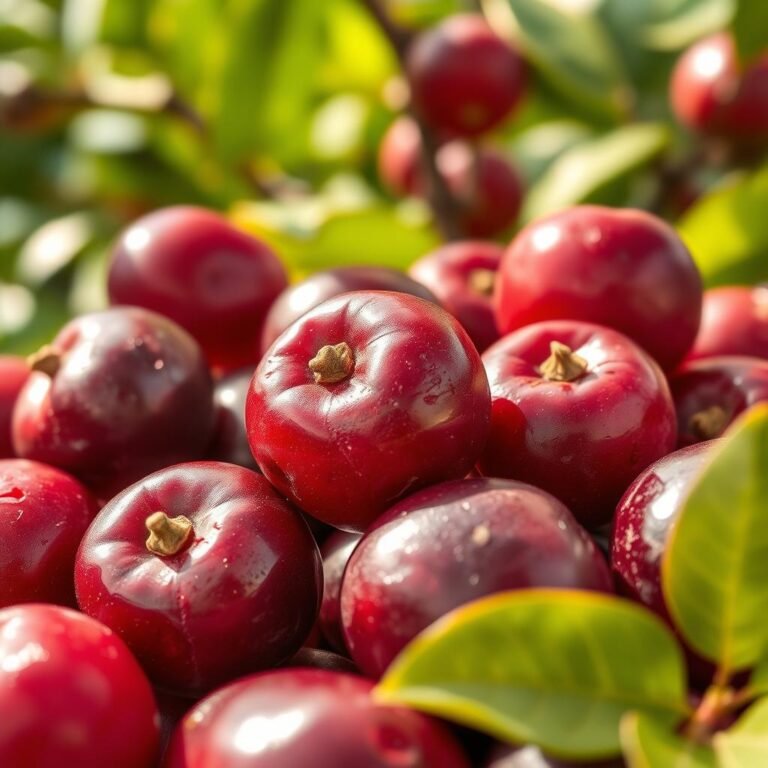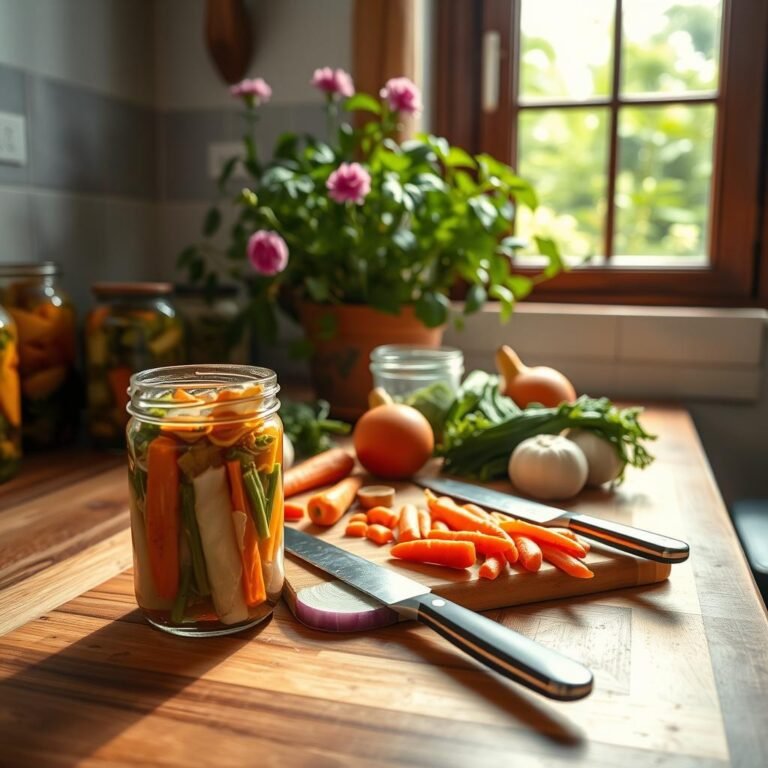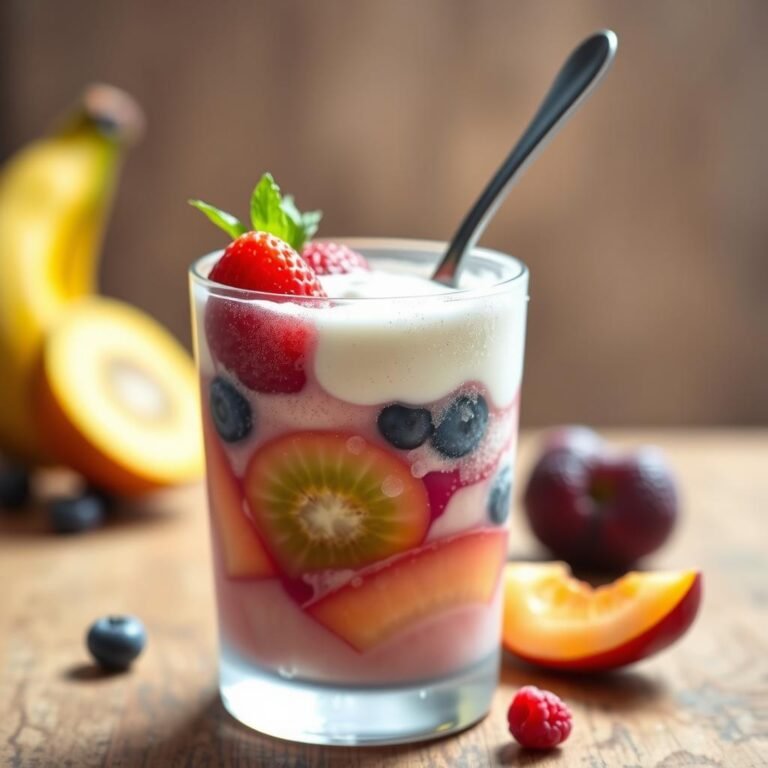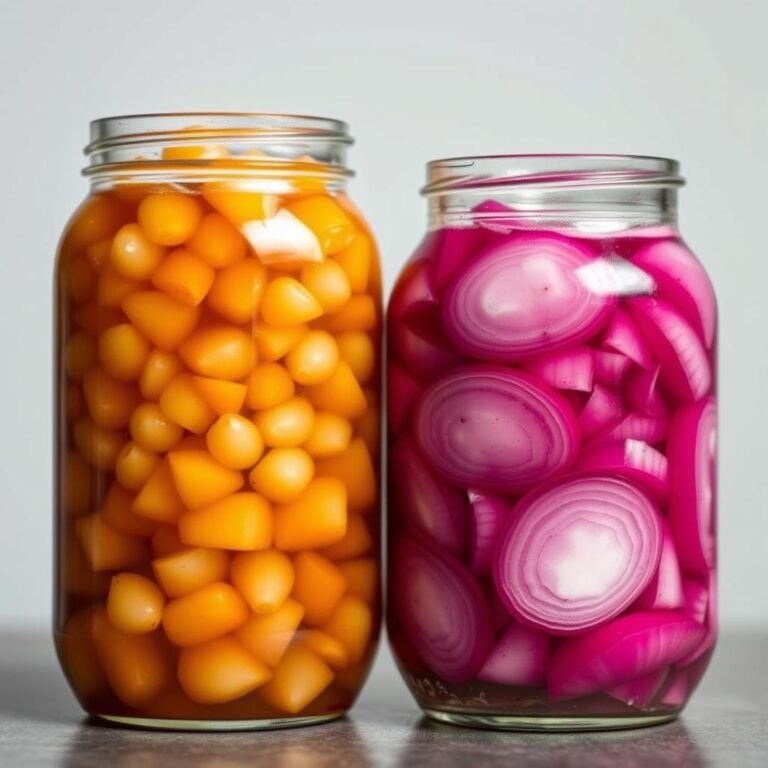How to Prepare White Kimchi Radish for a Healthy Gut
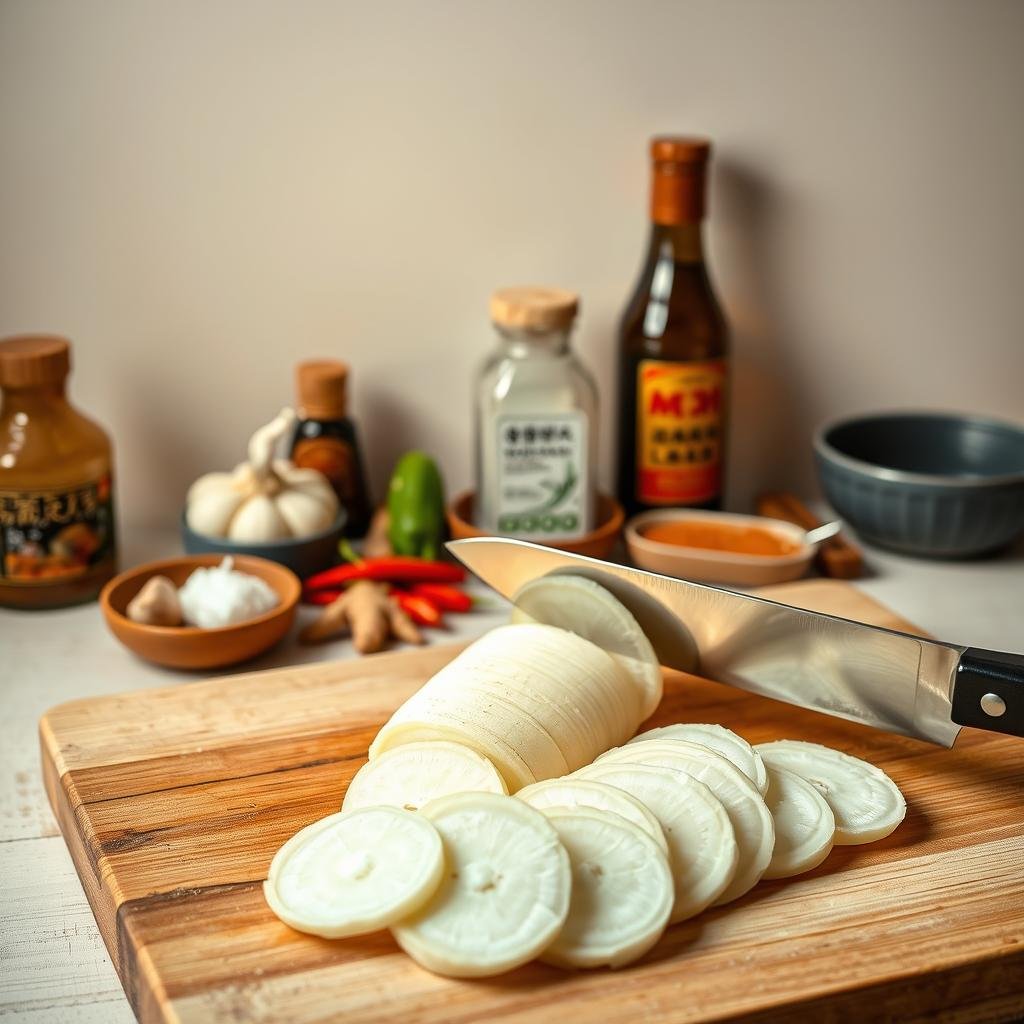
White kimchi radish is a tasty twist on traditional kimchi. It offers amazing flavor and health perks. Learning how to make white kimchi is fun for those who want to eat healthier. This guide shares a recipe from a Chicago Korean family, making it easy to follow.
This recipe is special because it doesn’t use gochugaru. This makes the flavor cleaner and less spicy. White kimchi tastes crisp, slightly sour, salty, and sweet. It’s a hit in summer.
It’s also packed with probiotics, fiber, and antioxidants. These are great for your gut and overall health.
By following this guide, you’ll learn to make white kimchi. You’ll also find a tasty way to boost your digestive health. Start now and see why it’s a favorite among healthy foods.
What is White Kimchi Radish?
Korean white kimchi, also called ‘baek kimchi,’ is a milder version of traditional Korean side dishes. It doesn’t have the red chili powder found in most kimchi. This dish is made with a clear broth or brine, giving it a light and crisp taste.
It’s a staple in Korean cuisine, loved for its cooling effect during hot summer months.
Origin and Cultural Significance
White kimchi radish comes from Korea, where it’s been loved for many generations. It’s known for its refreshing taste and is a favorite in Korean cuisine. The clear broth makes it less spicy than the red version, appealing to those who like milder flavors.
It often includes ingredients like Napa cabbage, Korean radish, apple, and pear. These add to its unique taste. For a detailed recipe, check out this link here.
Nutritional Benefits
White kimchi radish is very nutritious. It’s full of fiber, vitamins, antioxidants, and good probiotics. These nutrients help with digestion and boost the immune system.
It’s also rich in antioxidants, which fight oxidative stress and reduce inflammation. So, white kimchi radish is not just tasty but also good for your health.
Health Benefits of White Kimchi Radish
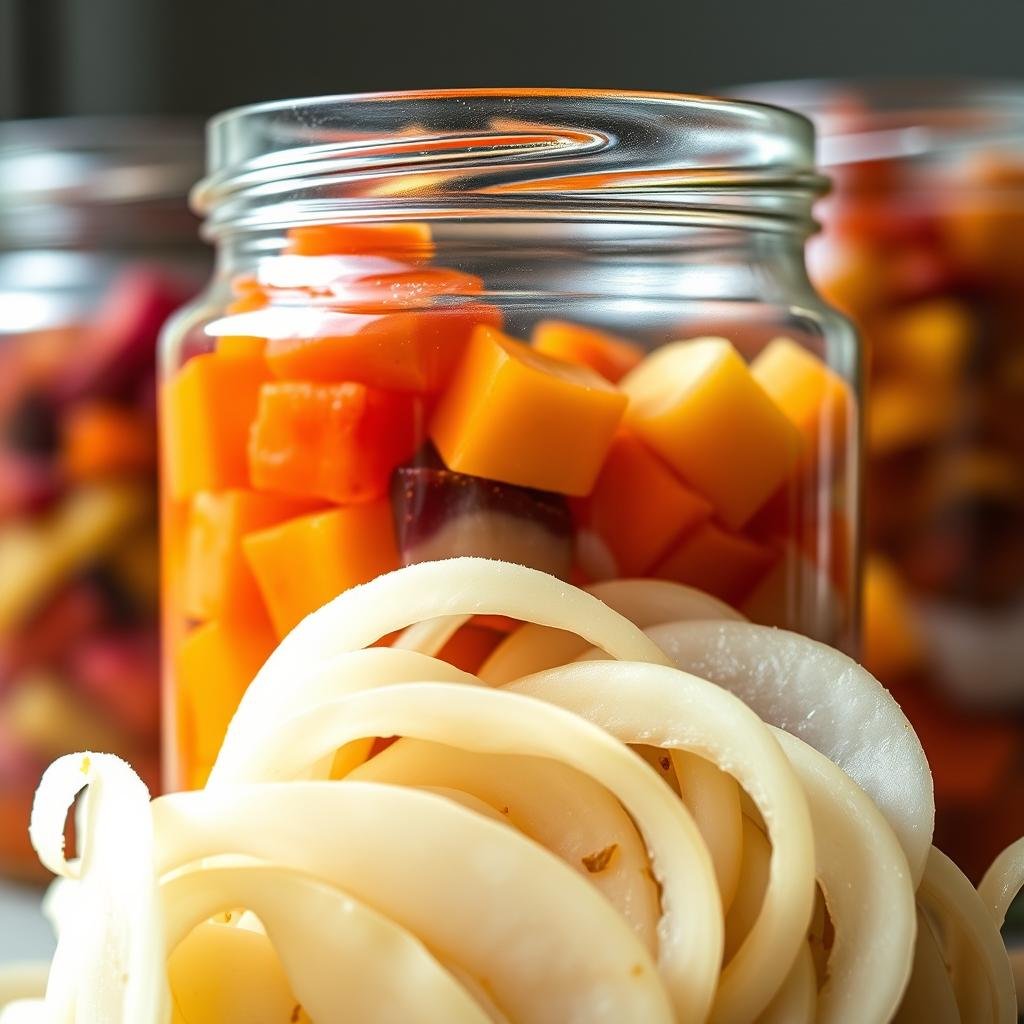
White kimchi radish is tasty and good for your health, mainly for your gut. It’s made by fermenting, which helps grow probiotics. These are key for a healthy stomach.
Promotes Digestive Health
White kimchi radish is great for your stomach. It’s full of probiotics from the fermentation. These good bacteria help digest food better, making nutrients easier to use and fixing issues like bloating.
Source of Probiotics
Probiotics are super important for a healthy gut. White kimchi radish is packed with them. Eating it helps your body absorb nutrients better and keeps your immune system strong.
Anti-Inflammatory Properties
Also, white kimchi radish fights inflammation. Research shows its lactic acid bacteria can lessen inflammation symptoms. It’s a key food for staying healthy and fighting inflammation.
Key Ingredients for White Kimchi Radish
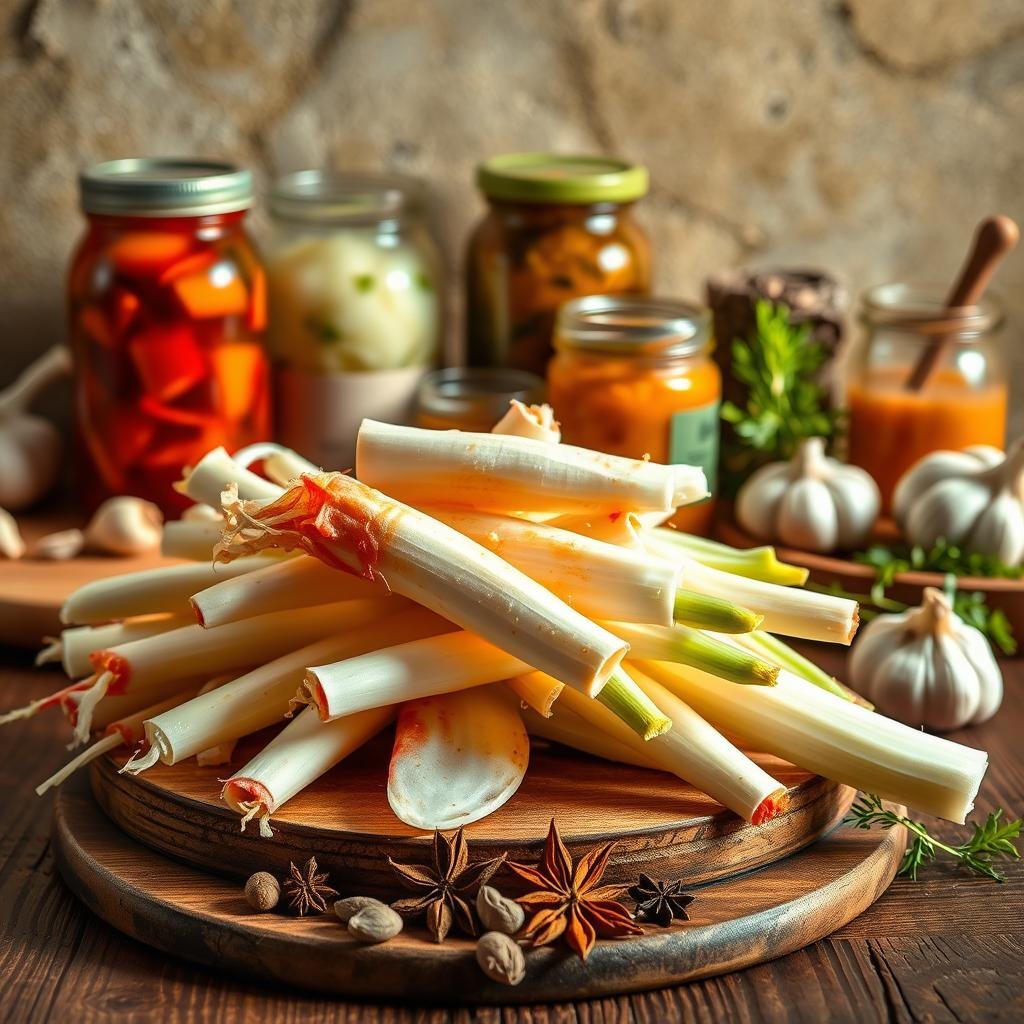
Making white kimchi radish needs fresh, quality ingredients. These ingredients mix to create a tasty blend. The main veggies, seasonings, and fermentation agents are key.
Essential Vegetables
The main veggies are Napa cabbage and Korean radish. They add unique textures and flavors. This makes the dish taste authentic.
- Napa Cabbage: It’s crisp and tender, great for soaking up flavors.
- Korean Radish: It brings a nice crunch and sweetness. This makes it a key part of healthy fermented foods.
Seasoning Spices
Seasoning white kimchi radish is important. It gives the dish its special taste.
- Garlic: It adds a strong flavor and aroma.
- Ginger: It adds a warm, spicy note that improves the taste.
- Mild Red Chiles (optional): Adding one to three chiles can add a bit of heat.
- Sugar: It balances the flavors with a touch of sweetness.
Fermentation Agents
Fermentation is key to making healthy fermented foods. The right agents make the process work well and create tasty kimchi.
- Sea Salt: It starts and keeps the fermentation going, making the flavors better.
- Fruit Juices (apple or pear): They add sweetness and nutrients. A mix of Korean pear and apples works well.
For a detailed recipe on making white kimchi radish, visit My Korean Kitchen.
Step-by-Step Preparation Guide
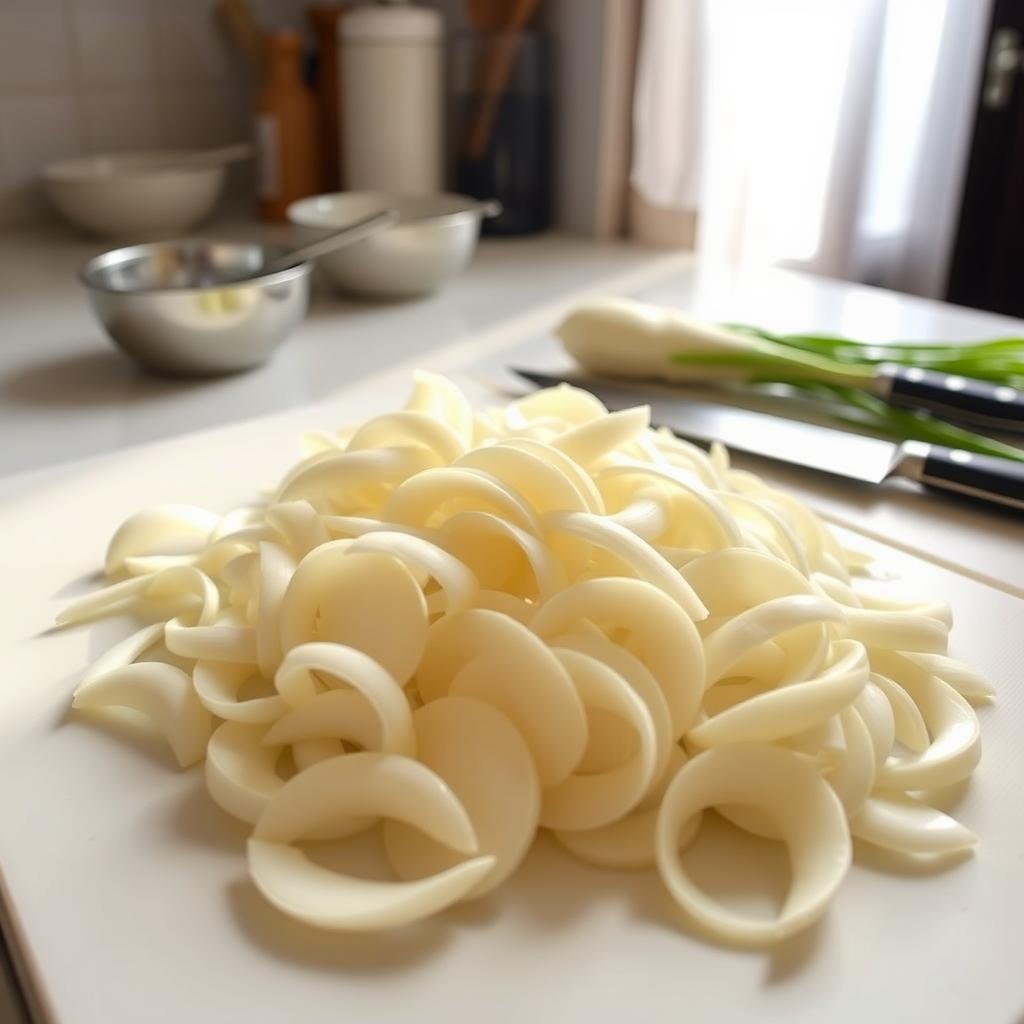
Learning to make white kimchi is rewarding. It starts with picking, cleaning, and slicing ingredients. Each step is key to making a tasty fermented radish recipe.
Selecting Fresh Radishes
Choosing the right radishes is key. Look for firm, crunchy, and blemish-free radishes. Korean radishes are preferred for their peppery and sweet taste.
Napa cabbage also adds to the flavor and texture of the kimchi.
Cleaning and Slicing Techniques
Cleaning is important to keep your recipe clean. Wash radishes and cabbage well under water. Remove radish tops and slice them into 2-inch sticks.
Slice them 1/2 inch wide and 1/8 inch thick. This helps in even fermentation for the best taste and texture.
Mixing Seasonings
Mixing seasonings is the next step. In a large bowl, mix green onion, onion, garlic, radish, carrot, salt, and sugar. Press down and let it sit for 15-20 minutes.
This softens the radish. Adding sweet fruits like apples or pears adds natural sweetness. More details are here.
Then, make a seasoned brine with sweet rice flour and water. Pour it into a jar with the vegetables. Fill it with water up to 80% of the jar’s capacity.
Taste and adjust with more salt or sugar if needed. This ensures flavors are evenly distributed for a balanced fermented radish recipe.
The Fermentation Process Explained
Making healthy fermented foods like white kimchi radish is an art. It needs understanding the fermentation process well. Getting the right flavors means paying close attention and following the best conditions.
Optimal Conditions for Fermentation
For fermentation to succeed, the right environment is key. The best temperature for fermenting white kimchi radish is room temperature. This means keeping it between 60-70°F (15-21°C).
It’s important to keep it airtight. This stops bad germs and keeps the good ones in balance.
Fermentation Duration
The time it takes to ferment can change based on what you like and how sour you want it. White kimchi radish usually ferments best at room temperature for three days. Then, move it to the fridge.
It will keep fermenting slowly there. This can take from a week to months. For more on making kimchi and other fermented foods, click here.
Signs of Successful Fermentation
Knowing when fermentation is done is important. Look for a tangy taste, a bit of fizz, and veggies that are tender but crisp. Checking the taste and texture often will tell you when it’s ready.
Making healthy fermented foods takes patience and care. Following these steps and ensuring the best fermentation will give you many health benefits. These include better digestion and more probiotics.
Troubleshooting Common Issues
Even the most seasoned kimchi makers can face issues. Learning how to make white kimchi, a cherished traditional Korean side dish, can be tricky. Addressing common problems early can help ensure a consistently delicious outcome.
Too Salty or Sour?
If your white kimchi tastes too salty or sour, several adjustments can be made. Over-salting may occur if too much salt is used during fermentation. To remedy this, rinse the vegetables thoroughly before serving to remove excess salt.
Shortening the fermentation time can prevent an overly sour taste. Regularly tasting during the process will help you to achieve the perfect balance.
Texture Problems
Ensuring the correct texture is key when learning how to make white kimchi. Vegetables that are too soggy often result from over-fermentation or insufficient salting. Make sure to salt the radish adequately before fermenting to draw out moisture.
Monitor the fermentation duration to avoid a mushy texture. Maintaining the crispness of the radish is essential for an authentic traditional Korean side dish.
Fermentation Odors
While some odor is expected during fermentation, extremely unpleasant smells may indicate contamination or improper sealing. Ensure that all equipment is sanitized before use. Also, make sure fermentation vessels are sealed correctly to create an anaerobic environment.
Properly storing the kimchi in an airtight container can help eliminate unwanted odors. This results in a delectable, aromatic dish.
Incorporating White Kimchi Radish in Your Diet
Adding Korean white kimchi radish to your meals can make them better and help your digestion. It tastes mild and is crunchy, perfect for many dishes. This part will show you how to use it every day.
Recipes Using White Kimchi Radish
White kimchi radish fits well in many recipes. It’s great in Korean dishes and modern meals. You can serve it with grilled meats or in rice bowls. It also makes Western dishes like sandwiches and salads better.
Daily Serving Suggestions
It’s easy to add Korean white kimchi to your meals. A small amount at breakfast, lunch, or dinner boosts your health. It’s good with spicy foods, balancing flavors. Try to eat it once or twice a day for its health perks.
Incorporating into Snacks
Looking for healthy snacks? Korean white kimchi radish is a crunchy choice. You can put it on crackers, in wraps, or enjoy it alone. It’s easy to add to your snacks and keeps them tasty and healthy.
| Meal Type | How to Incorporate |
|---|---|
| Breakfast | Add to omelets or breakfast wraps |
| Lunch | Include in salads or sandwiches |
| Dinner | Serve alongside grilled meats or rice bowls |
| Snacks | Top on crackers or use in wraps |
White Kimchi Radish vs. Traditional Kimchi
White kimchi radish and traditional Korean side dish, red kimchi, are similar but different. They have different tastes, nutritional values, and ways of making them.
Flavor Differences
White kimchi radish tastes milder and crisper. It doesn’t have gochugaru, which makes it less spicy. This makes it great for kids, the elderly, and those who don’t like spicy food.
Nutritional Comparisons
White kimchi radish is healthier than spicy kimchi. It has fewer calories and less sodium. It also has less capsaicin, which is good for those with sensitive stomachs.
| Nutrient | White Kimchi Radish | Traditional Kimchi |
|---|---|---|
| Calories | less | more |
| Sodium | lower | higher |
| Spice Level | milder | spicier |
Preparation Techniques
Making white kimchi radish is different from traditional kimchi. It uses napa cabbage, Korean radish, carrot, and green onion. The seasoning includes a flour slurry, garlic, ginger, and a broth from Asian pear or red apple. For a detailed recipe, check this guide.
Tips for Making White Kimchi Radish
Making a tasty white kimchi radish is easy. Just a few tips can help a lot. First, clean your radishes well and cut them into 1-inch pieces. This helps them ferment evenly and makes your dish better.
Common Mistakes to Avoid
Don’t over-salt your white kimchi radish. Salt is key, but too much makes it bad. Use about 6 tablespoons of sea salt, divided, and let it sit for a day at room temperature. Also, make sure to store it right. Keep it in a closed container in the fridge for months.
Adaptations for Beginners
Beginners should start small. Try adding 4 medium green onions and 4 garlic cloves, thinly sliced. You can also add sugar and salt to taste. For a full guide, check out this resource.
Tools and Equipment
The right tools make a big difference. You’ll need airtight containers for fermentation. Good knives are key for even cuts. Also, use big mixing bowls to mix everything well.

